Plant Profiles
Click on the first letter of the common name of the plant you wish more information about.
A | B | C | D | E | F | G | H | I | J | K | L | M | N | O | P | Q | R | S | T | U | V | W | X | Y | Z
M
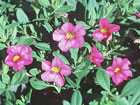
Million Bells
Scientific Name: Calibrachoe hybrid
Growth Habit: A perennial, usually treated like an annual, with a sprawling habit growing to 12 inches tall and over 24 inches wide. The leaves are bright green, lancelike and growing to 1 inch long and 1/2-inch wide.
Light: Grow in full-sun to lightly shaded locations.
Feedings: Apply a general garden fertilizer to in-ground plantings monthly; feed container plantings every other week.
Water Needs: Drought tolerant. In-ground plantings grow best with weekly waterings; moisten container plantings when the soil begins to feel dry.
Ease of Culture: Easy.
Propagation: Start plants from cuttings.
Hardiness: Hardy; damaged only by a severe freeze.
Major Problems: Aphids and whiteflies are piercing, sucking insects that may be found feeding on the foliage. Control with a soap spray as needed. Overwatering may cause root rot problems; prevent by planting in a well-drained soil.
Pruning: Gardeners may want to remove faded flowers from container gardens to keep them attractive. Also trim vigorous shoots that compete with neighboring plants. Plants used as an edging may occasionally need to be trimmed from sidewalks.
Uses: Million bells grows best as an annual addition to flower gardens and planters fall through spring. The bushy, rambling plants fill with 1-inch-diameter bell-shaped flowers of red, yellow, orange and pink colors October through May. They are well-suited to hanging baskets and planters where the stems cascade over the sides. Mix with contrasting annual flowers for an attractive display. Plants decline during the summer months, likely because of the heat and humidity.
Florida Native: No; a hybrid with relatives in South America.
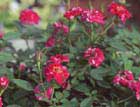
Miniature Roses
Scientific Name: Rosa chinensis minima
Growth Habit: An evergreen, usually rounded shrub growing to 2 feet tall and containing numerous small limbs.
Light: Plant in full-sun locations.
Feedings: Apply a general garden fertilizer monthly to in-ground plantings; feed container plantings every other week.
Water Needs: Needs frequent watering. Thoroughly moisten when the surface soil begins to dry.
Ease of Culture: Medium; success depends on a good care program.
Propagation: Start new plants from cuttings.
Hardiness: Hardy.
Major Problems: Like other relatives, miniature roses are affected by black spot, mites and similar garden pests. Spray programs are usually needed to prevent plant decline.
Pruning: Miniature roses gradually grow large and out of bounds. Overgrown plants are usually sheared to about one-half their height and width. Faded flowers and declining limbs also are removed as needed.
Uses: Miniature roses can be grown in containers or as bedding plants to create spots of color in home and commercial landscapes. Because of the care needed, it`s often best to plant in groups of several miniature roses. New hybrids have produced plants of many colors, flower forms and growth habits including the variety Jolly Cupido with red and white blossoms.
Florida Native: No; native to China.
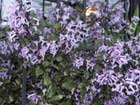
Mona Lavender Plectranthus
Scientific Name: Plectranthus hybrid
Growth Habit: An evergreen perennial with numerous stems growing to a rounded plant 3 feet tall and wide. The leaves are deep green with purplish veins, slightly curled at the edges with short coarse teeth and growing to 2 inches long and 1 inch wide.
Light: Plant in filtered sun to shade.
Feedings: Fertilize in-ground plantings every six to eight weeks with a general garden plant food; feed container plantings every other week with a houseplant product or use a slow-release fertilizer at the label rate.
Water Needs: Prefers a moist soil. In-ground plantings grow best with twice-a-week waterings; container plantings often need daily waterings during hot, dry weather.
Ease of Culture: Easy.
Propagation: Start plants from cuttings.
Hardiness: Tender; damaged by frosts and freezes but can grow back from stems near the ground protected by mulch.
Major Problems: Check for mealybugs and mites that are common plectranthus problems. Control with soap or oil sprays as needed. May also be damaged by chewing insects, but controls are seldom needed.
Pruning: Encourage a compact growth habit by periodically trimming the tips of new shoots. Keep plants inbounds by pruning shoots hanging over walkways and affecting nearby plantings. Remove old flower heads as the blooms decline.
Uses: A colorful new plant for container gardens to display at entrances, on patios and as a balcony or porch display. Also use as a bedding plant for annual or perennial gardens to provide colorful fall foliage and flowers. More than 6-inch-long spikes of lavender blossoms open August through April unless affected by cold.
Florida Native: No; hybridized in South Africa.
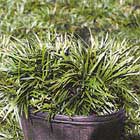
Mondo Grass
Scientific Name: Ophiopogon japonicus
Growth Habit: An evergreen perennial in the lily family with 1/4-inch-wide, upright, straplike, dark green leaves originating from buds near ground level and growing to 12 inches tall.
Light: Shady to to filtered-sun areas.
Feedings: Use a garden fertilizer once in March and June if needed to spur growth.
Water Needs: Drought tolerant; keep new plantings moist until roots grow into the surrounding soil. Thereafter water every 10 to 14 days during periods of drought.
Ease of Culture: Easy.
Propagation: Start new plants by dividing older established clumps.
Hardiness: Hardy.
Major Problems: Plantings are usually pest free but can develop root rot if overwatered or planted in poorly drained soils. Even though it's often called a grass, this is a lily relative that is damaged by foot traffic.
Pruning: Mondo grass grows slowly but can eventually encroach upon other nearby plantings. Dig out clumps and relocate to keep the plants in bounds.
Uses: Gardeners needing a care-free ground cover should consider mondo grass as turf replacement in shady locations. Also called monkey grass, dwarf lily turf and border grass, plantings make an excellent low edging along walkways and near patios. Mondo grass produces short spikes of lavender or white blooms usually hidden among the foliage May through July. Plants can be used in container gardens and Oriental landscape designs.
Florida Native: No; native to Japan and Korea.
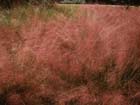
Muhly Grass
Scientific Name: Muhlenbergia capillaris
Growth Habit: A clump-forming ornamental grass with upright to arching leaves growing to 3 feet tall. The leaves are bright green and rolled to give a rounded appearance about a quarter-inch in diameter.
Light: Grow in full-sun locations.
Feedings: Can exist with nutrients from mulches and plant residues; grows best with light lawn-fertilizer applications once monthly in March, June and August.
Water Needs: Drought tolerant; can survive with seasonal rainfall but forms lower-growing plants. Grows best in moist locations or with irrigation.
Ease of Culture: Easy.
Propagation: Start plants from seed or by division of older clumps.
Hardiness: Hardy.
Major Problems: Grow in well-drained sites to prevent root-rot problems. Older plants gradually decline and need to be replaced with new container-grown selections or seedlings that result from nearby plants.
Pruning: Plantings turn brown during the winter months and need renewal pruning during February before growth begins. During the warmer months, plants may grow into nearby plantings or over walkways and need trimming.
Uses: A low-maintenance ornamental for use in foundation plantings, along walkways and wildflower, rock or perennial gardens. The plants, also commonly known as mist grass, remain green throughout most of the year; September through November, they sport red-to-purplish airy inflorescences held well above the foliage. Plantings are salt tolerant and can be used along banks and other hard-to-maintain areas.
Florida Native: Yes.
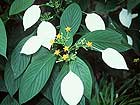
Mussaenda
Scientific Name: Mussaenda species
Growth Habit: Large evergreen shrubs with open branching habits growing to 12 feet tall and wide. The leaves have prominent veins, are elliptical, bright green and grow to 6 inches long and half as wide.
Light: Plant in full-sun to lightly shaded locations.
Feedings: Apply a general garden fertilizer once monthly in March, June and September.
Water Needs: Tolerates short periods of drought; grows best with weekly waterings.
Ease of Culture: Easy; will need pruning.
Propagation: Start plants from cuttings.
Hardiness: Tender; susceptible to frosts and freezing temperatures but grows back from stems near the ground.
Major Problems: Grows as an open and often gangly shrub. Better growth habits can be encouraged with frequent pruning. Plant in a well-drained soil to avoid root rot problems. Shrubs may also be affected by chewing insects, but controls are seldom needed.
Pruning: Remove cold-damaged plant portions in late February and reshape plants not affected by the cold. Occasionally trim back the tips of new shoots and remove old flower heads to develop more compact plants and additional blooms.
Uses: Plants develop colorful inflorescences that resemble those of poinsettias, but they are not related. The modified leaves, called sepals, are white, yellow, pink or red depending on the species. They develop their colors June through December. The true flowers are yellow to red in color and small. They are found in the center of the inflorescence. Use as accent plants near patios or along walkways. Mussaenda may also be planted as a backdrop for flowerbeds or other shrubs and used as a view barrier during the warmer months.
Florida Native: No; native to Asia and Africa.

